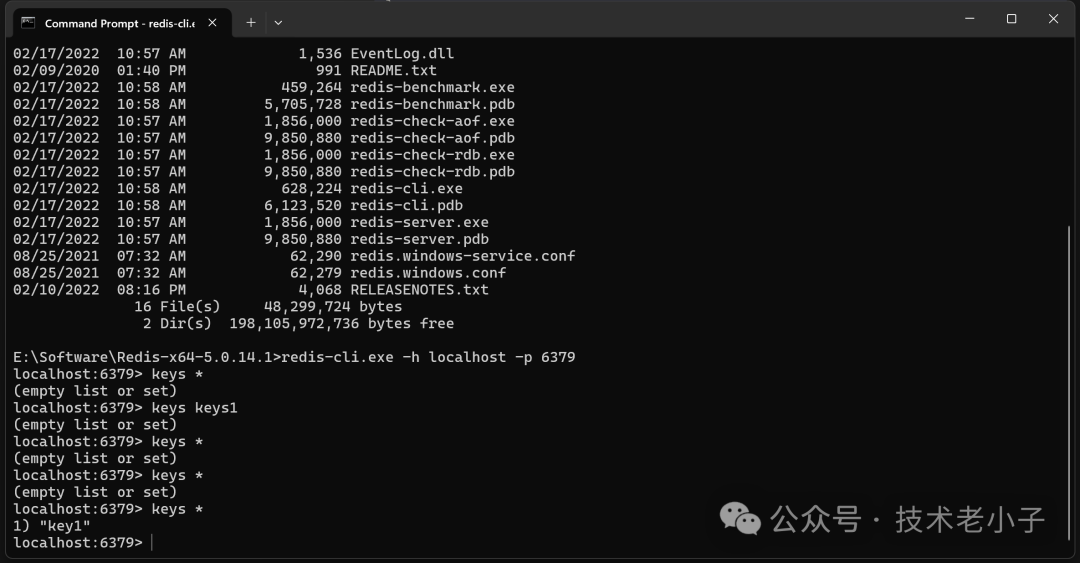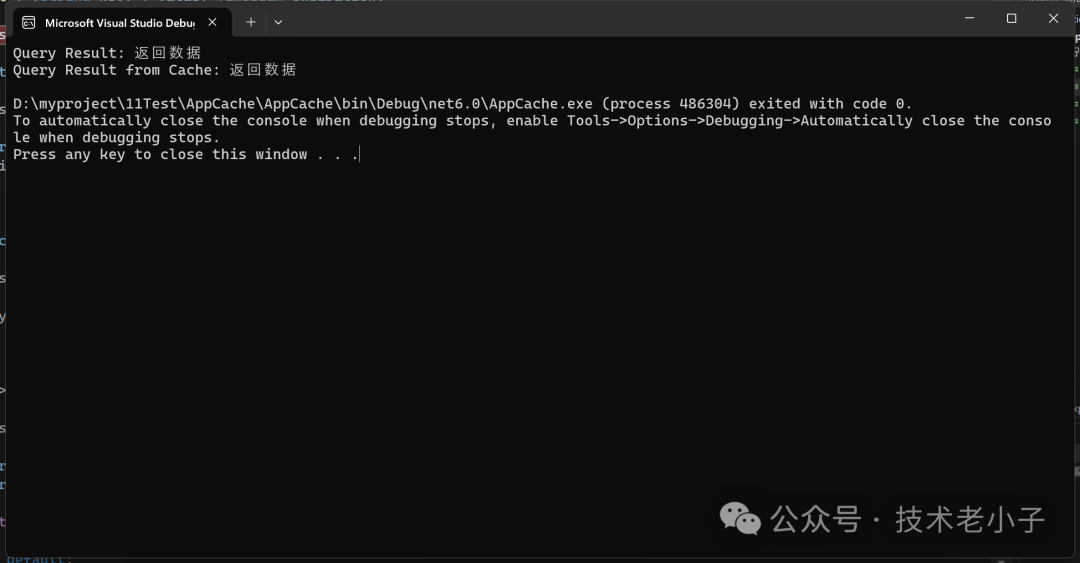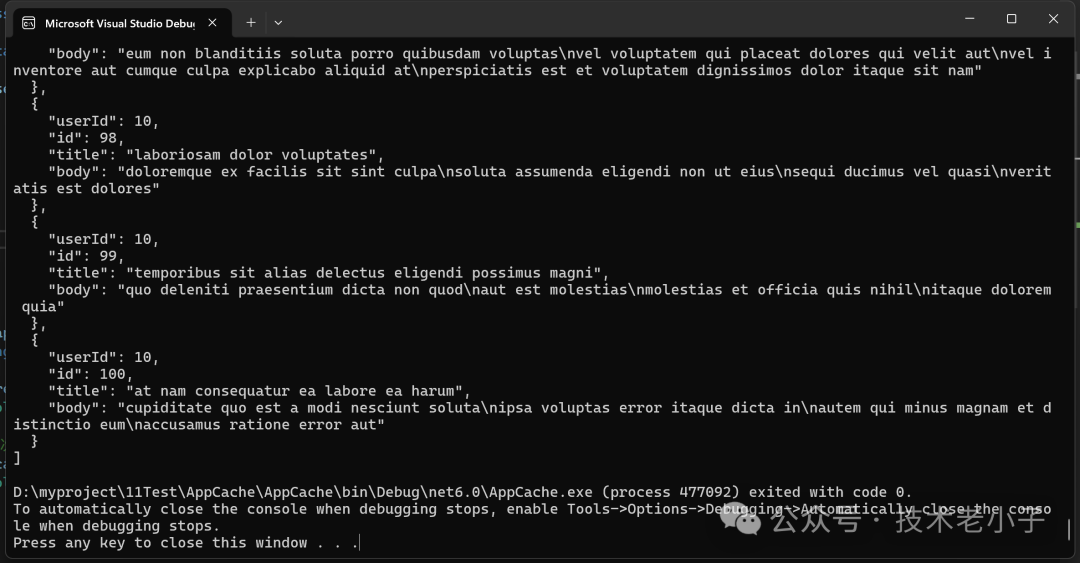我們聊聊 C# 通用 Cache 緩沖類開發指南
在現代應用程序中,緩存是一種有效的優化手段,能夠顯著提高系統的性能,減少延遲。緩存可以用于數據庫查詢結果的存儲、API 響應的緩存、復雜計算結果的保存等多個場景。本文將介紹如何開發一個通用的 CacheService 類,并展示其在不同場景中的應用。
引言
緩存是一種存儲機制,用于臨時性地保存數據,以減少數據獲取的時間和頻次。在高性能應用程序中,合理使用緩存,可以顯著提高系統的響應速度,減輕后臺服務的負擔。接下來我們講解如何開發一個通用的 CacheService 并展示其在具體場景中的應用。
開發通用的 CacheService
ICacheService 接口
首先,定義一個 ICacheService 接口,定義基本的緩存操作:
using System;
using System.Threading.Tasks;
public interface ICacheService
{
void Set<T>(string key, T value, TimeSpan expiration);
T Get<T>(string key);
Task SetAsync<T>(string key, T value, TimeSpan expiration);
Task<T> GetAsync<T>(string key);
void Remove(string key);
Task RemoveAsync(string key);
}CacheService 實現
接下來,開發 CacheService 類,它實現了 ICacheService 接口。該類同時支持內存緩存和分布式緩存(例如 Redis),基于啟動時的配置選擇緩存方式:
using System;
using System.Threading.Tasks;
using Microsoft.Extensions.Caching.Memory;
using Microsoft.Extensions.Caching.Distributed;
using Microsoft.Extensions.Logging;
public class CacheService : ICacheService
{
private readonly IMemoryCache _memoryCache;
private readonly IDistributedCache _distributedCache;
private readonly ILogger<CacheService> _logger;
private readonly bool _useDistributedCache;
public CacheService(IMemoryCache memoryCache, IDistributedCache distributedCache, ILogger<CacheService> logger, bool useDistributedCache = false)
{
_memoryCache = memoryCache;
_distributedCache = distributedCache;
_logger = logger;
_useDistributedCache = useDistributedCache;
}
public void Set<T>(string key, T value, TimeSpan expiration)
{
if (_useDistributedCache)
{
var options = new DistributedCacheEntryOptions
{
AbsoluteExpirationRelativeToNow = expiration
};
var serializedValue = System.Text.Json.JsonSerializer.Serialize(value);
_distributedCache.SetString(key, serializedValue, options);
}
else
{
var cacheEntryOptions = new MemoryCacheEntryOptions
{
AbsoluteExpirationRelativeToNow = expiration
};
_memoryCache.Set(key, value, cacheEntryOptions);
}
}
public T Get<T>(string key)
{
if (_useDistributedCache)
{
var serializedValue = _distributedCache.GetString(key);
if (serializedValue != null)
{
return System.Text.Json.JsonSerializer.Deserialize<T>(serializedValue);
}
return default;
}
_memoryCache.TryGetValue(key, out T value);
return value;
}
public async Task SetAsync<T>(string key, T value, TimeSpan expiration)
{
if (_useDistributedCache)
{
var options = new DistributedCacheEntryOptions
{
AbsoluteExpirationRelativeToNow = expiration
};
var serializedValue = System.Text.Json.JsonSerializer.Serialize(value);
await _distributedCache.SetStringAsync(key, serializedValue, options);
}
else
{
var cacheEntryOptions = new MemoryCacheEntryOptions
{
AbsoluteExpirationRelativeToNow = expiration
};
_memoryCache.Set(key, value, cacheEntryOptions);
}
}
public async Task<T> GetAsync<T>(string key)
{
if (_useDistributedCache)
{
var serializedValue = await _distributedCache.GetStringAsync(key);
if (serializedValue != null)
{
return System.Text.Json.JsonSerializer.Deserialize<T>(serializedValue);
}
return default;
}
_memoryCache.TryGetValue(key, out T value);
return await Task.FromResult(value);
}
public void Remove(string key)
{
if (_useDistributedCache)
{
_distributedCache.Remove(key);
}
else
{
_memoryCache.Remove(key);
}
}
public async Task RemoveAsync(string key)
{
if (_useDistributedCache)
{
await _distributedCache.RemoveAsync(key);
}
else
{
_memoryCache.Remove(key);
}
}
}配置依賴注入
在項目的 Program.cs 中配置依賴注入:
using System;
using Microsoft.Extensions.DependencyInjection;
using Microsoft.Extensions.Caching.Memory;
using Microsoft.Extensions.Caching.Distributed;
using Microsoft.Extensions.Logging;
public class Program
{
static void Main(string[] args)
{
var serviceProvider = new ServiceCollection()
.AddMemoryCache()
.AddStackExchangeRedisCache(options =>
{
options.Configuration = "localhost:6379";
})
.AddLogging()
.AddSingleton<CacheService>()
.BuildServiceProvider();
// 使用緩存服務的示例
var cacheService = serviceProvider.GetService<CacheService>();
cacheService.Set("key1", "value1",new TimeSpan(0, 10, 0));
var value = cacheService.Get<string>("key1");
}
}我們還可以啟用分布試的緩沖(Redis);
static void Main(string[] args)
{
var serviceProvider = new ServiceCollection()
.AddMemoryCache()
.AddStackExchangeRedisCache(options =>
{
options.Configuration = "localhost:6379";
})
.AddLogging()
.AddSingleton<CacheService>(sp =>
{
var memoryCache = sp.GetRequiredService<IMemoryCache>();
var distributedCache = sp.GetRequiredService<IDistributedCache>();
var logger = sp.GetRequiredService<ILogger<CacheService>>();
return new CacheService(memoryCache, distributedCache, logger, useDistributedCache: true);
})
.BuildServiceProvider();
// 使用緩存服務的示例
var cacheService = serviceProvider.GetService<CacheService>();
cacheService.Set("key1", "value1",new TimeSpan(0, 10, 0));
var value = cacheService.Get<string>("key1");
} 圖片
圖片
緩存應用場景示例
數據庫查詢結果緩存
DatabaseService.cs
using System;
public class DatabaseService
{
private readonly ICacheService _cacheService;
public DatabaseService(ICacheService cacheService)
{
_cacheService = cacheService;
}
public string GetDataFromDatabase(string query)
{
string cacheKey = $"DatabaseQuery-{query}";
var cacheData = _cacheService.Get<string>(cacheKey);
if (cacheData != null)
{
return cacheData;
}
// 模擬數據庫查詢操作
string data = "返回數據";
_cacheService.Set(cacheKey, data, TimeSpan.FromMinutes(5));
return data;
}
}程序入口
internal class Program
{
static void Main(string[] args)
{
var serviceProvider = new ServiceCollection()
.AddMemoryCache()
.AddStackExchangeRedisCache(options =>
{
options.Configuration = "localhost:6379";
})
.AddLogging()
.AddSingleton<CacheService>()
.AddSingleton<ICacheService, CacheService>()
.AddSingleton<DatabaseService>()
.BuildServiceProvider();
var databaseService = serviceProvider.GetService<DatabaseService>();
string query = "SELECT * FROM Users";
Console.WriteLine("Query Result: " + databaseService.GetDataFromDatabase(query));
// 再次調用以展示緩存效果
Console.WriteLine("Query Result from Cache: " + databaseService.GetDataFromDatabase(query));
}
} 圖片
圖片
API 響應緩存
ApiService.cs
using System;
using System.Net.Http;
using System.Threading.Tasks;
public class ApiService
{
private readonly ICacheService _cacheService;
private readonly HttpClient _httpClient;
public ApiService(ICacheService cacheService, HttpClient httpClient)
{
_cacheService = cacheService;
_httpClient = httpClient;
}
public async Task<string> GetApiResponseAsync(string url)
{
string cacheKey = $"ApiUrl-{url}";
var cacheData = await _cacheService.GetAsync<string>(cacheKey);
if (cacheData != null)
{
return cacheData;
}
var response = await _httpClient.GetStringAsync(url);
await _cacheService.SetAsync(cacheKey, response, TimeSpan.FromMinutes(10));
return response;
}
}程序入口
using System.Net.Http;
using System.Threading.Tasks;
public class Program
{
public static async Task Main(string[] args)
{
var serviceProvider = new ServiceCollection()
.AddMemoryCache()
.AddStackExchangeRedisCache(options =>
{
options.Configuration = "localhost:6379";
})
.AddLogging()
.AddSingleton<HttpClient>()
.AddSingleton<CacheService>()
.AddSingleton<ICacheService, CacheService>()
.AddSingleton<ApiService>()
.BuildServiceProvider();
var apiService = serviceProvider.GetService<ApiService>();
string apiUrl = "https://jsonplaceholder.typicode.com/posts";
var result = await apiService.GetApiResponseAsync(apiUrl);
Console.WriteLine("API Response: " + result);
// 再次調用以展示緩存效果
var cachedResult = await apiService.GetApiResponseAsync(apiUrl);
Console.WriteLine("Cached API Response: " + cachedResult);
}
} 圖片
圖片
復雜計算結果緩存
CalculationService.cs
using System;
public class CalculationService
{
private readonly ICacheService _cacheService;
public CalculationService(ICacheService cacheService)
{
_cacheService = cacheService;
}
public int HeavyComputation(int input)
{
string cacheKey = $"HeavyComputation-{input}";
var cacheData = _cacheService.Get<int>(cacheKey);
if (cacheData != 0)
{
return cacheData;
}
// 模擬復雜計算
int result = input * input;
_cacheService.Set(cacheKey, result, TimeSpan.FromMinutes(10));
return result;
}
}程序入口
public class Program
{
public static void Main(string[] args)
{
var serviceProvider = new ServiceCollection()
.AddMemoryCache()
.AddStackExchangeRedisCache(options =>
{
options.Configuration = "localhost:6379";
})
.AddLogging()
.AddSingleton<CacheService>()
.AddSingleton<ICacheService, CacheService>()
.AddSingleton<CalculationService>()
.BuildServiceProvider();
var calculationService = serviceProvider.GetService<CalculationService>();
int input = 42;
Console.WriteLine("Computation Result: " + calculationService.HeavyComputation(input));
// 再次調用以展示緩存效果
Console.WriteLine("Cached Computation Result: " + calculationService.HeavyComputation(input));
}
}總結
本文介紹了如何開發一個通用的 CacheService,并展示了其在不同場景中的應用:數據庫查詢結果緩存、API 響應緩存、復雜計算結果緩存。這種通用的緩存服務設計,可以顯著提高應用的性能和響應速度,減少對外部資源(如數據庫、外部 API)的頻繁訪問,從而優化用戶體驗。
通過上述示例,開發者可以更輕松地在項目中集成和管理緩存,提高應用的整體性能和可靠性。希望本文對你有所幫助,能夠在實際項目中充分利用緩存技術。





































